Underbone (Called "Motor bebek" in Indonesia," Kap Cai" in Singapore/Malaysia, "Papi/Papaki" in Greece) is a type of motorcycle which sets its main focus on economy and practicality while having better stability than average scooters. These bikes are widely used in Indonesia, Vietnam, India, Thailand, Laos, Cambodia, Taiwan, Phillipines, and so much more. Underbones are often confused with scooters and mopeds.
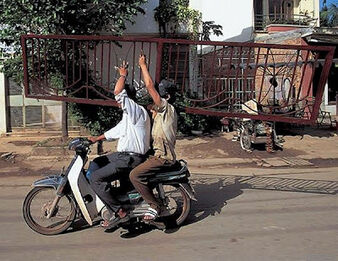
A passenger carrying a load on an underbone bike.
Common Usage[]
Underbones are widely used, especially in tropical Asian countries. This is by far the most suitable type of bike to be used for economy needs as they are simple and more practical than standard bikes.
Some underbones feature a seat that can carry up to 3-4 average Asian size passengers for family needs. Underbone's bigger rim size compared to scooters gives better stability over gravels and

They are often being used as a family transport in developing Asian countries.
roads with bad condition commonly found in developing countries, especially the country side.
Aside from private use and family needs,
underbones replace the task of commercial cars at certain countries such as mail delivery van, ice cream van, ambulance, and even taxi. Motorcycles have the ability to cut through lanes faster than cars (Which is legal in certain countries) and they are also cheaper to run than commercial cars.
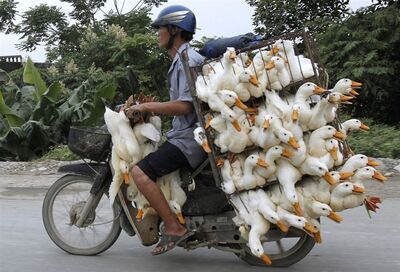
Example of commercial use in Vietnam.
Design[]
The appearance and frame of an underbone is quite different to that of a motorcycle, but the powertrain is functionally almost identical. The underbone engine is positioned between the rider's feet but the rear wheel is driven by a regular motorcycle secondary chain drive. Styling considerations only mean that the chain driven nature of the machine tends
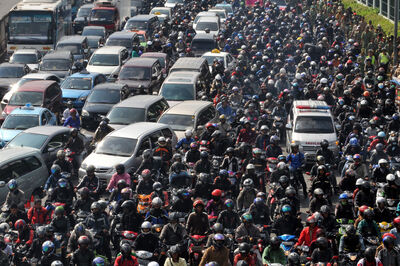
In some countries like Vietnam and Indonesia, underbones are the majority vehicles.
to be concealed under sheet-metal covers to a greater extent than that of motorcycles.
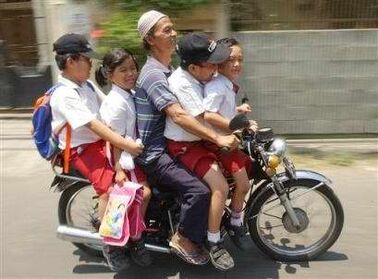
The flexible seat design is suitable for carrying more people.
Underbones can have spoked or alloy wheels which are spindle mounted, usually the size fitted to small conventional motorcycles. These provide much better road-holding and braking than scooters, though it does make the (increasingly rare) punctures more difficult to repair. Historically, underbones led the way in semi-automatic transmissions and indicator systems. In other respects, the technical sophistication of underbones has tended to lag those of larger motorcycles, but they increasingly have similar electronic ignition, fuel injection etc.In only one significant respect does the underbone differ from the conventional motorcycle - there is no frame member or fuel tank between the seat base and the headstock. Generally the fuel tank is under the riders seat. The underbone arrangement improves
ease of mounting and dismounting and contributes to the cross-gender appeal of the layout as an around-town shopping and commuter vehicle. The engine size of a typical underbone is generally between 50 cc and up to about 150 cc, though much bigger ones are available.
Contemporary underbones are also styled in a rather more exciting way. Often advertisements are trying to add elements that are not associated with practicality, such as sportiness. Excessive use of graphic design on the product's vynil also plays an important role on the image of the product.
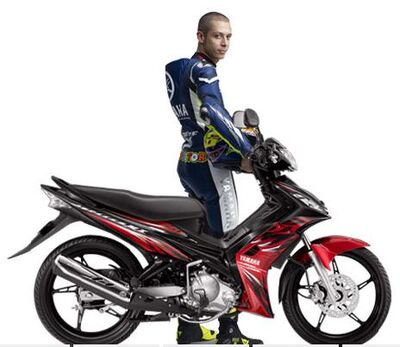
Famous Moto GP racer, Valentino Rossi featured in the advertisement of Yamaha Jupiter.
History
The underbone concept can be seen in some
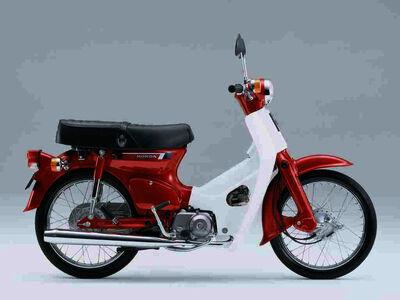
Honda Super Cub is the most popular underbone outside Asia. It is also the bike that inspires numerous economy bikes in Asia.
of the European mopeds of the early 1950s, including the NSU and the Henkei Perley.The spine-framed, plastic-faired Honda Super Cup is the most produced motorcycle of all time.Production of the Super Cub began in 1958, surpassing 60 million units in April 2008, and continuing to be made in several countries around the world As of 2012.